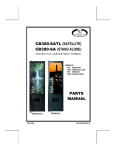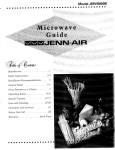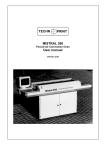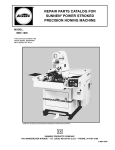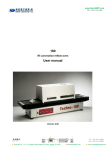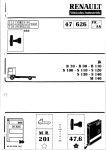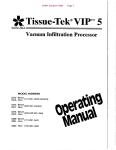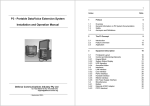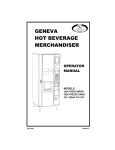Download Can/Bottle 10 Selections Vending Machine Service Manual
Transcript
CAN/BOTTLE 10 SELECTIONS VENDING MACHINE SERVICE MANUAL Models 3172, 3172A, 3196 INTRODUCTION This manual contains instructions, service and installation guidelines. Read and follow the instructions to minimize set-up time. Become familiar with the features and functions. It is equipped with an electronic control system. All programming of the Vend functions, pricing and features is done on the control board. Changes can be made without any additional accessories or remote parts. MODEL & SERIAL NUMBER Record the Model and Serial Number of your vending machine on the space below. The numbers are on the identification plate on the backside of the vending machine. Refer to these numbers on all correspondence and inquiries concerning this vending machine. They are needed if service and parts information is required for your vending machine. MODEL NUMBER: _________________ SERIAL NUMBER: _________________ If you have any questions regarding the information in the manual, replacement parts or the operation of the vending machine you should contact your local distributor or service entity. UNPACKING This vending machine was thoroughly inspected before leaving the factory and the delivering carrier has accepted this vending machine as their responsibility. Any damage or irregularities should be noted at the time & delivery and reported to the carrier. Request a written inspection report from the claims inspector to file any claim for damage. File the claim with the carrier (not the manufacturer) within 15 days after receipt of the vending machine. Carefully remove the outside packing material in a manner not to damage the finish or exterior of the vending machine. Inspect the vending machine for concealed shipping damage. Report any damage hidden by the shipping material directly to the delivering carrier on a Hidden Damage Report. Remove the “Knock-Away” support by sliding a pallet jack under the vending machine, inserting a screwdriver or prying tool into the groove of the KnockAway and splitting it in two as shown in Figure 1. Turn the leveling screws in as far as possible. INSTALLATION GROUNDING (EARTHING) & ELECTRICAL Prior to connecting the equipment, the integrity of the main electrical supply must be checked for correct polarity, voltage, (earth) ground, and (amperage) circuit protection. The fuse or breaker protecting the circuit must be rated at 15 amps or greater. It is recommended that these checks be repeated at 6 month intervals with the routine safety electrical testing of the equipment itself. To correct negative voltage, amperage, polarity, or ground (earth) checks, consult a qualified electrician. A noise suppresser has been installed in this vending machine to compensate for any signal noise that could interfere with the normal operation of the control board. Vending Machine must be grounded for noise suppressor to work. WARNING: DO NOT USE EXTENSION CORDS. Consult local, state and federal codes and regulations before installation of the vending machine. To minimize installation time and to avoid service problems due to improper installation, follow the instructions outlined in this manual. Position the vending machine in its place of operation no further than six feet from the power outlet or receptacle and check that the door will open fully without interference. Leave at least four inches of space between the back of the vending machine and any wall or obstruction for proper air circulation. CAUTION: Do not block the vent openings in front or in the rear of the vending machine. Always allow free ventilation behind a bank installation, so that exhaust air is not trapped. Failure to do so could result in a refrigeration failure. Level the vending machine, making sure all levelers are touching the floor. The vending machine must be level for proper operation. If it is properly leveled, it should not “rock” or “teeter on any of the levelers. When the vending machine is level, the door can be opened to any position and not move by itself. Try the door half closed, straight out and in a wide-open position before deciding that the vending machine is level. Remove all shipping brackets, tape and inner packing material from the vending machine. Operating the vending machine without removing the tape and packing material could result in damage to the vending machine. INSTALL BOTTOM KICK PANEL 1. Open main door. Remove the Kick Panel from inside the Vend Rack. 2. Remove wing nuts from Kick Panel threaded studs. Save for step 6. 3. Open inner door. 4. Position Kick Panel under the main door with louvers facing front. See Figure 2. 5. Push Kick Panel threaded studs through holes in the bottom of the main door. 6. Lock the Kick Panel into position by re-installing the three (3) wing nuts as shown on Figure 2. 7. Close inner door and main door. WARNING: This vending machine is equipped with a 3 amp circuit breaker to protect the vend circuit only. The refrigeration system is not on this breaker. LOADING VEND RACK IMPORTANT SUGGESTION: Load the front rack with products that sell faster. When loading, fill the rear selections first. This method makes it easier to load the rack. 1. Products featured in front door Live Display must match the product being loaded. 2. Funnel slides must be kept clean. Refer to Figure 4 for part names, locations and product orientation. 3. Refer to Figure 4. Product container bottoms must face towards the center of the rack as shown. 4. Do not store bottles in “spare” space of the cabinet. The refrigeration unit could be damaged. 5. A loading chart has been provided on the inner door to make it easier to keep track of what types of products have been loaded into the 10 Selection Drink Vending Machine. Use a dry erase marker to avoid making a permanent mark. 6. If refilling with the same product size into the same column, then load products into the columns. Skip steps 7 through 11. 7. If a) loading for the first time, or b) changing a column to a different product size or c) to reset product cradle (motor) to correct position, then load one row of products in each column and test vend each column using real money. CAUTION Do not load dented or damaged cans or bottles in the columns. Possible jams could occur. 8. Add five (5) rows of products in each column to check product spacing. Products should not have more than 1/4 to 1/2 inches of free space at the front or back of the columns. See Figure 4. Adjust the back spacer, latch striker or gate assembly to achieve the required dimension. The Vend Rack has been factory set for most 20-oz. bottles or I 2-oz. cans. If vending 16.9-oz water bottles, remove Filler (4211816) from the back of the inner door and install it in the Vend Rack. Follow instructions on Filler decal. To adjust the back spacer: Lift the back spacer and reposition it in the adjustment slots. Use notch markers as reference points to align it vertically. See Figure 4. To adjust the latch striker and gate assembly: Pull and lift up on the lower end of the gate assembly (or latch striker). Use a small screwdriver as a wedge to gently pry the dimple away from the slot opening. See Figure 4. Reposition them in the adjustment slots. Use notch markers as reference points to align it vertically. 9. If product spacing is correct, then test vend each column using real money. 10. Load the columns to full capacity. LIVE DISPLAY Make sure that the Live Display price and selection labels are set and installed correctly. Labels and product containers must face outward toward the customer and must match the products being loaded. See Figure 5. LOADING THE LIVE DISPLAY 1. Open the main door, and then open the Inner Door. 2. Firmly grip the top edge of the Live Display. Lift it up then pull. Allow it to swing down to loading position. See Figure 6. 3. Insert the can or bottle between the spring retainers. See Figure 7. 4. Close the Live Display. DROP SENSOR A drop (vibration) sensor on the delivery chute detects if a product has been vended after a selection is made. The control board located on the back of the main door controls the drop sensor sensitivity. The drop sensor sensitivity is factory calibrated and should not need adjustment. NOTE: Please refer to DROP SENSOR instructions in the CONTROLLER PROGRAMMING section of this manual to restore the drop sensor sensitivity to factory settings. NORMAL VEND OPERATION 1. STAND-BY CONDITION When the control board is in sales mode the display will show “ICE Cold” or the amount of credit. If a customer presses a selection before establishing a credit, the vend price for that selection more will display, signaling the customer that money is needed for that selection. 2. ESTABLISHING CREDIT Feeding the coins into the coin changer or bills into the bill changer results in the display of the corresponding credit value. The coin changer or bill changer will accept money until the highest vend price has been reached or exceeded. At this point a credit has been set up through the control board that will enable a vend for any established selection less than or equal to the credit. 3. VALID SELECTION Making a selection causes the selection switch to close. A logic level signal is constantly sent out from the control board that then travels to each switch’s common position. When the switch is dosed, the signal travels out the normally closed position to the harness connection to the control board. 4. VEND SEQUENCE The control board then distributes 24 volts DC through the door and cabinet wiring harnesses and to the coil of the selected product cradle motor. At the same time, the display will scroll. This indicates to the customer that a vend is in progress. As the product cradle motor receives power, it will turn the product cradle, attempting to vend a can or bottle. 5 PRODUCT DELIVERY As the can or bottle drops onto the product delivery chute, the impact or vibration allows the drop sensor to send a low voltage signal to the control board indicating that a product has been vended. After receiving the drop sensor signal, the control board will recognize how the vendor is programmed and responds accordingly. Refer to Can/Bottle Menu section on page 2 for additional features. CONTROLLER PROGRAMMING CONTROL BOARD This vending machine has a GVCI control board. It is connected to product cradle motors arranged in a linear (non-matrix) method. It is also connected to a drop sensor (impact vibration) for delivery detection. Open the main door, and then open the inner door. The control board is located on the back of the main door (on the left side). See Figure 9. SALES MODE The vending machine defaults to sales mode when it is turned on. While it is in sales mode, the display will show the amount of credit. SERVICE MODE Pressing the service mode button while the vending machine is in sales mode will activate service mode. It will display the number of working motors. While in Service Mode, the control board will automatically revert to Sales Mode after one (1) minute if a keypad button is not pressed. CAN & BOTTLE CONFIGURATION CAN SETTNG IS NORMALLY USED WITH DOUBLE-DEPTH LOADING OF CANS TO DOUBLE THE PRODUCT CAPACITY OF THAT SELECTION. DURING A VEND, THE PRODUCT CRADLE STOPS ROTATING AS THE DROP SENSOR DETECTS A VEND. THIS IS TO PREVENT DOUBLE VENDING. BOTTLE SETTING IS NORMALLY USED WITH SINGLE-DEPTH LOADING OF BOTTLES. THIS SETTING ALLOWS THE PRODUCT CRADLE TO CONTINUE ROTATING A FEW MORE SECONDS SO THAT IT IN POSITIONED CLOSER TO THE LOADING ZONE. THIS REDUCES THE CUSTOMER’S WAITING TIME WHEN THE PRODUCT CRADLE IS ACTIVATED TOR THE NEXT VEND. THE CONTROLLER HAS BEEN CONFIGERED TO OPERATE A CAN VENDING MACHINE AND ALL SELECTIONS ARE SET TO VEND CANS. FOLLOW THE STEPS BELOW TO RESTORE THE CONTROLLER TO A CAN VENDING MACHINE, OR TO SET ALL OR SOME SELECTIONS TO VEND BOTTIES. REFRIGERATION CAUTION: Do not place any object in the evaporator assembly area or inside the Cabinet area that will block the airflow. This may damage the refrigeration system, which may void the refrigeration warranty. REFRIGERATION TROUBLESHOOTING Know and understand how to service the unit and how it operates. Units may vary, but the operation is basically the same. Never guess at the problem; find the symptom before attempting any repair. NOTE: 90% of refrigeration problems are electrical. Unauthorized work done to the sealed hermetic system will void the warranty. The sealed hermetic system is not to be worked on outside the Factory Service Center. The three things that can go wrong with a sealed system and should be repaired at the Factory Service Center are: 1. Low Charge - usually caused by leaks; look for oil around seals and welds. Unit will not cool properly. The capillary tube will be frosted before it enters the evaporator inlet tube. 2. Restriction in Systems (unit frost, then melts) - not cooling properly. 3. Bad valves - unit does not cool properly; noisy compressor. COMPRESSOR WILL NOT START A. Vending machine not plugged in. B. Tripped breaker or blown fuse. C. Faulty wall outlet. D. Short or tear in power cord. E. Improper wiring. F. Low voltage: 5 % below. Check the power source with the Multi-Meter. G. Overload defective: Trips too fast. Check overload with the Multi-Meter. H. Start relay defective: Check start relay with the Multi-Meter. I. Compressor has open windings. Check compressor windings with a Multi-Meter. J. Defective thermostat. 1. Unplug the Vending Machine power cord from the electrical wall outlet. 2. Remove condenser assembly mounting screws. Refer to Figure 13. A. Remove bottom condenser assembly screws. B. Remove power panel screws (4 places). Remove power panel. C. Remove sealant cover screws (2 places). Remove sealant cover. Remove sealant. D. Remove hopper mounting screws (3 places). 3. Refer to Figure 14: A. Gently remove hopper and set it on the right side. B. Remove hopper bracket screws (2 places). Remove hopper bracket. C. Remove the clamp screw holding the temperature sensor. Remove the temperature sensor. D. Remove evaporator screws. 4. Carefully move wire harness ad cables out of the way. 5. Grip the front lip of the condenser base and the evaporator base and pull out at the same time. See Figure 15. 6. To re-install the refrigeration unit, then reverse the steps. CARE & CLEANING WARNING: Always disconnect the power before cleaning. CABINET EXTERIOR Wash with a mild detergent and water, rinse and dry thoroughly. Wipe occasionally with a quality car wax. Plastic exterior parts may be cleaned with a quality plastic cleaner. CABINET INTERIOR Wash with a mild detergent and water. Including baking soda or ammonia in the cleaning solution may eliminate odors. Remove and clean drain hose to eliminate any deposits that may restrict condensate water flow. The vend mechanisms should be kept clean. Any build-up of syrup deposits can cause the mechanisms to malfunction. Use soap and water with great care so as not to get water into the electrical components. To insure proper vending keep delivery slide area free of dirt and sticky substances. REFRIGERATION SYSTEM Clean dust from condenser and screen in the front door with a soft bristle brush or vacuum cleaner. Remove any dirt or debris from the refrigeration system compartment. Remove and clean the condensation pan. Do not block the evaporator or any area of the airflow with product or supplies. PARTS ORDERING PROCEDURE PLEASE HAVE THE FOLLOWING INFORMATION: • The model number and serial number of the vending machine. • Correct part number and description from the pertinent part and/or parts manual. If you do not have the right parts manual, go online to www.vendnetusa.com or contact VendNet and we will provide a copy for you. NOTE: When Right and Left” are used with part name, it is taken to mean that the person is facing the vending machine with the door closed. • Shipping address. • Address where the invoice should be sent. • The number of parts required. • Any special shipping instructions. Carrier desired: air or air special, truck, parcel post, or rail. If ordering by rail, need a signature and date. • If a purchase order number is used, be sure that it is visible and legible. BEFORE CALLING FOR SERVICE PLEASE CHECK THE FOLLOWING: • Does your vending machine have at least 4” of clear air space behind it? • If the power is turned on at the fuse box, is the vending machine the only thing that doesn’t work? • Is the vending machine plugged directly into the outlet? • Is the evaporator coil free of dust and dirt? • Is the condenser coil free of dust and dirt? • Is the compressor free of dust? (A blanket of dust can prevent the compressor from cooling off between workouts). • Is the circuit breaker at the fuse box reset? • Are evaporator fans running? Take a sheet of paper approx. 4” x 5” in size. Place the paper in front of the evaporator coil and see if the evaporator fans will draw the paper to the coil. • Is the condenser fan running? Fold a sheet in front of the condenser coils and see if it draws the paper to it. • Is the shelf in front of the evaporator coil clear? (No tools or other air restricting items). • Is the cold control set between 0 and 2? NOTE: Setting the cold control higher does not accelerate cooling of product.




















